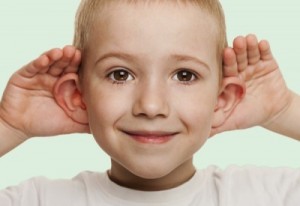 The term auditory processing refers to how the brain perceives and interprets sound information. Several skills determine auditory processing ability—or listening success. They develop in a general four-step hierarchy, but all work together and are essential for daily listening. Although researchers do not agree on the exact hierarchy of skills, they generally agree on what skills are essential for auditory processing success. (Cochlear Americas, 2009; Johnson et al., 1997; Nevins & Garber, 2006; Roeser & Downs, 2004; Stredler-Brown & Johnson, 2004)
The term auditory processing refers to how the brain perceives and interprets sound information. Several skills determine auditory processing ability—or listening success. They develop in a general four-step hierarchy, but all work together and are essential for daily listening. Although researchers do not agree on the exact hierarchy of skills, they generally agree on what skills are essential for auditory processing success. (Cochlear Americas, 2009; Johnson et al., 1997; Nevins & Garber, 2006; Roeser & Downs, 2004; Stredler-Brown & Johnson, 2004)
Step 1:
Auditory Awareness – the ability to detect sound.
Sound Localization – the ability to locate the sound source.
Auditory Attention/Auditory Figure-Ground – the ability to attend to important auditory information including attending in the midst of competing background noise.
Step 2:
Auditory Discrimination of Environmental Sounds – the ability to detect differences between sounds in the environment.
Auditory Discrimination of Suprasegmentals – the ability to detect differences in non-phoneme aspects of speech including rate, intensity, duration, pitch, and overall prosody.
Auditory Discrimination of Segmentals – the ability to detect differences between specific speech sounds.
Step 3:
Auditory Identification (Auditory Association) – the ability to attach meaning to sounds and speech.
Auditory Feedback/Self-Monitoring – the ability to change speech production based on information you get from hearing yourself speak.
Phonological Awareness (Auditory Analysis) – the ability to identify, blend, segment, and manipulate oral language structure.
Step 4:
Auditory Comprehension – the ability to understand longer auditory messages, including engaging in conversation, following directions, and understanding stories.
Auditory Closure – the ability to make sense of auditory messages when a piece of auditory information is missing; filling in the blanks.
Auditory Memory – the ability to retain auditory information both immediately and after a delay.
Linguistic Auditory Processing – the ability to interpret, retain, organize, and manipulate spoken language for higher level learning and communication.
Source: Super Duper Publications
Activities for home or classroom targeting auditory skills:
Absurdities: listen carefully to the text and identify errors and what doesn’t make sense.
Auditory Reception: listen to the text and answer yes/no, true/false, and basic knowledge and reasoning questions.
Comprehension: listen to a story, then choose a title for the story and answer questions about the story.
Details: listen to, retain, and answer questions about specific parts of what is heard
Exclusion: listen to and process information in order to answer questions that contain negative markers (e.g., not, doesn’t, can’t, isn’t).
Following Directions: differentiate informative sentences from directions, listen for specific pieces of information, identify ambiguities in directions, and know when to ask for information.
Main Idea: identify the main idea of a list of details and tell the main idea of a message.
Phonological Awareness: identify rhymes, generate rhyming words, and identify words that start or end with a given sound.
Problem Solving: identify problems, predict their probable causes, and identify appropriate solutions.
Riddles: listen to clues and identify the target item.
Target Skill: Auditory Discrimination
 Within the realm of Auditory Processing, Auditory Discrimination is broken down into these areas:
Within the realm of Auditory Processing, Auditory Discrimination is broken down into these areas:
Auditory Discrimination of Environmental Sounds
The ability to detect differences between sounds in the environment.
Auditory Discrimination of Suprasegmentals
The ability to detect differences in non-phoneme aspects of speech including rate, intensity, duration, pitch, and overall prosody.
Auditory Discrimination of Segmentals
The ability to detect differences between specific speech sounds.
Skill Builders
 Below are some helpful apps and activities that you can do with your child to improve their auditory discrimination skills:
Below are some helpful apps and activities that you can do with your child to improve their auditory discrimination skills:
Environmental Sounds
What’s That Sound? Learning to Listen and Identify Sounds (iPhone and iPad App)
This interactive game develops auditory discrimination and processing skills in young learners. Players will improve their skills by matching objects and their associated sounds.
Kazoo
 To help your child with sound discrimination and processing use a kazoo with your child and have them imitate the pattern of the “toots” with varying pitch, duration, and tempo, and volume.
To help your child with sound discrimination and processing use a kazoo with your child and have them imitate the pattern of the “toots” with varying pitch, duration, and tempo, and volume.
- Blow into the kazoo and the child must imitate the number of “toots” he or she hears. This is a listen and repeat tasks. “Toot” three times, then the child “toots” three times. This correlates with the number of syllables in a word.
- Vary duration pattern of the “toots.” For example: short-long-short or long-long-short.
- Vary the pitch pattern of the “toots.” For example: low-low-high or high-low-high.
(Lynn Carahaly, MA, CCC-SLP, “Auditory Processing Deficits in Children with CAS: Effects on Speech 2012)
Auditory Closure
What’s Missing? Game
Have your child works on filling in “missing” information, using contextual clues. Use short, easy sentences such as “I –eep in a bed” or “You have two –eet”. Have the child repeat the sentence correctly.
Pay particular attention to high-frequency sounds, such as s/sh/f/th/k/t and especially ending sounds. Vowels usually are heard pretty clearly.